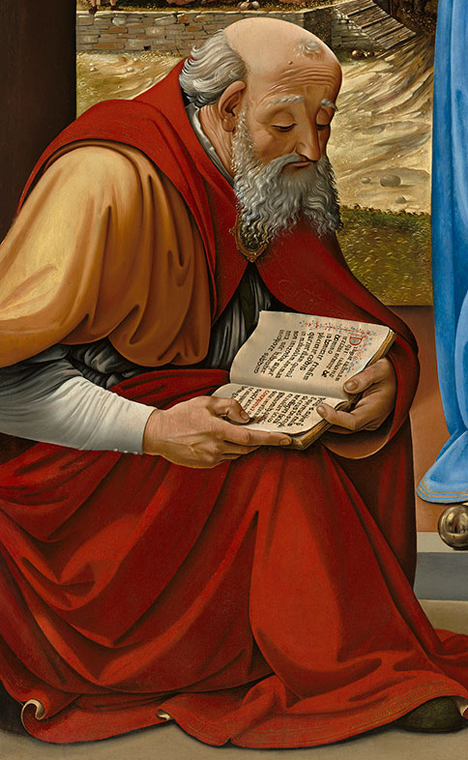The Visitation

The joined hands of Mary and Elizabeth are the focus of Piero’s panel, the exact spiritual and physical center of the composition. As recounted in the Gospel of Luke, “When Elizabeth heard Mary’s greeting, the child leaped in her womb. And Elizabeth was filled with the Holy Spirit and exclaimed with a loud cry, ‘Blessed are you among women, and blessed is the fruit of your womb.’”

At background right appears the Annunciation, when the angel Gabriel descended on the Virgin Mary and announced, “You will conceive in your womb and bear a son, and you will name him Jesus” (Luke 1:31). Piero has represented the miraculous event as a mural painted on the side of a building—perhaps because the conception of Christ had already taken place by the time of the Visitation. This fictive fresco demonstrates the artist’s imaginative approach to sacred narrative.

At left, Piero depicts the future adoration of the infant Christ by shepherds. Mary kneels humbly on the ground beside the Child.

The barely visible entourage of the Magi winds down a hillside.

When King Herod heard of the birth of Christ, he ordered the slaughter of all infants in Bethlehem. Piero shows the massacre of the innocent babes in mothers’ arms spilling out of buildings and down the steps at right. A child clings precariously to a ledge, while a lamb flees the violence.

Saint Anthony balances his leather writing case in a fold of his heavy drapery. Having replenished the ink in his quill, the ascetic furrows his brow as he peers at his parchment through distinctive black spectacles. Piero has portrayed a real pair of Renaissance eyeglasses, examples of which survive to the present day. The saint is accompanied by his attributes: bell, cross-shaped staff, and a roving pig with gold-tipped highlights on his back.

Saint Nicholas reads excerpts from the opening of the Book of Wisdom, beginning, “Love justice, you who judge the earth; think of the Lord in goodness, and seek him in integrity of heart.” The meticulous Latin letters with their red and blue decoration accurately depict an illuminated manuscript from Piero’s time.

The three golden balls at Nicholas’ feet allude to an early legend of the saint’s charity. Hearing of three poor daughters whose desperate father was about to sell them into prostitution, Nicholas disguised himself as a common man and threw three balls of gold into their window. The gift supplied each maiden with a marriage dowry. In Piero’s ingenious conception, the delicate spheres reflect the interior of a church. The artist’s biographer, Giorgio Vasari, described the balls “shining and casting gleams of light and reflections from one another.”

A single sprig of wallflower, symbolizing divine love, lies at the feet of the two saints. Its placement near the expectant mothers recalls its use since antiquity as an herbal remedy to lessen the pain of childbirth.

High on an exterior railing of the palazzo at right, a creature that appears to be a monkey scuttles along, nearly unnoticed.